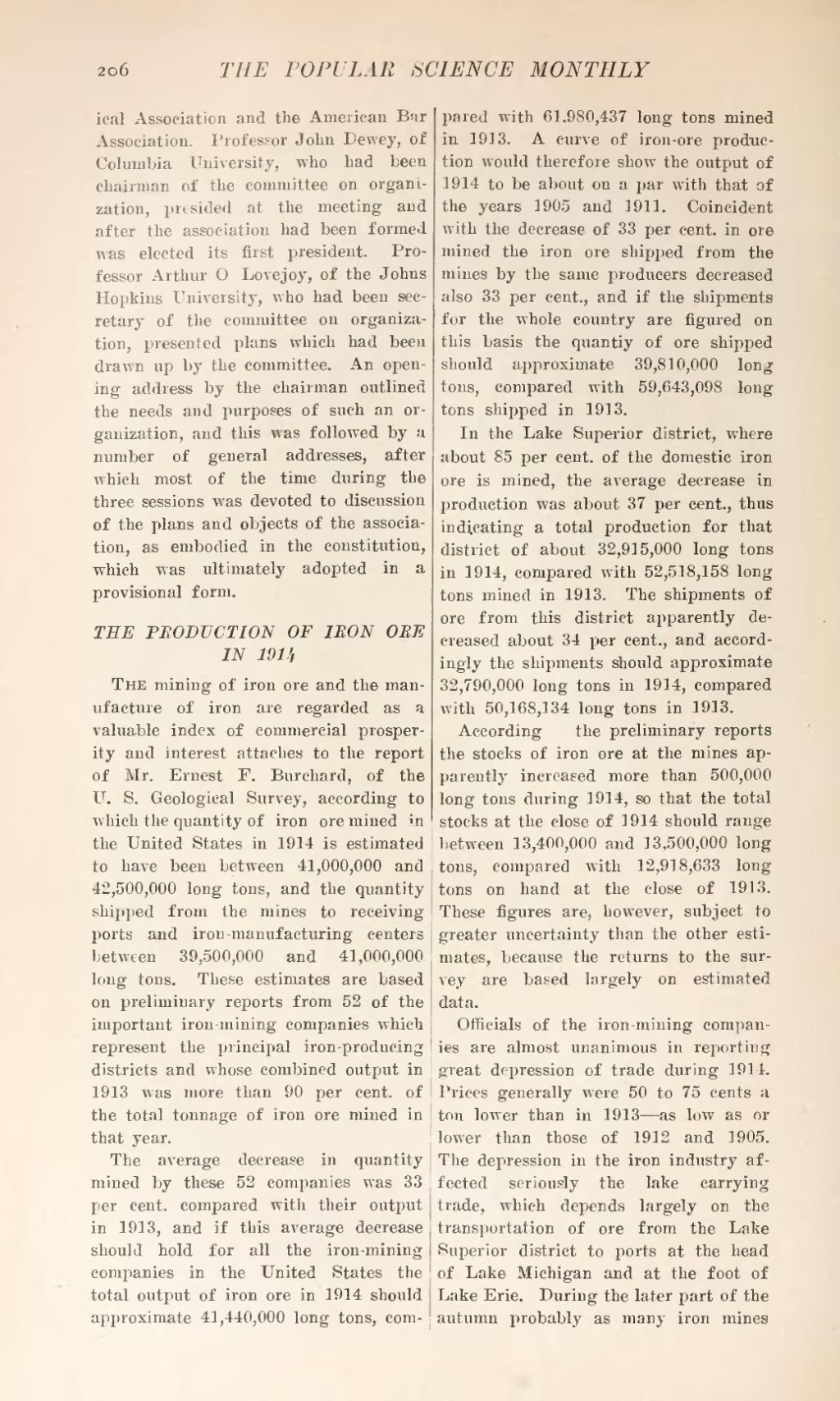ical Association and the American Bar Association. Professor John Dewey, of Columbia University, who had been chairman of the committee on organization, presided at the meeting and after the association had been formed was elected its first president. Professor Arthur O Lovejoy, of the Johns Hopkins University, who had been secretary of the committee on organization, presented plans which had been drawn up by the committee. An opening address by the chairman outlined the needs and purposes of such an organization, and this was followed by a number of general addresses, after which most of the time during the three sessions was devoted to discussion of the plans and objects of the association, as embodied in the constitution, which was ultimately adopted in a provisional form.
THE PRODUCTION OF IRON ORE IN 1914
The mining of iron ore and the manufacture of iron are regarded as a valuable index of commercial prosperity and interest attaches to the report of Mr. Ernest F. Burchard, of the U. S. Geological Survey, according to which the quantity of iron ore mined in the United States in 1914 is estimated to have been between 41,000,000 and 42,500,000 long tons, and the quantity shipped from the mines to receiving ports and iron-manufacturing centers between 39,500,000 and 41,000,000 long tons. These estimates are based on preliminary reports from 52 of the important iron-mining companies which represent the principal iron-producing districts and whose combined output in 1913 was more than 90 per cent, of the total tonnage of iron ore mined in that year.
The average decrease in quantity mined by these 52 companies was 33 per cent, compared with their output in 1913, and if this average decrease should hold for all the iron-mining companies in the United States the total output of iron ore in 1914 should approximate 41,440,000 long tons, compared with 61.980,437 long tons mined in 1913. A curve of iron-ore production would therefore show the output of 1914 to be about on a par with that of the years 1905 and 1911. Coincident with the decrease of 33 per cent, in ore mined the iron ore shipped from the mines by the same producers decreased also 33 per cent., and if the shipments for the whole country are figured on this basis the quantiy of ore shipped should approximate 39,810,000 long tons, compared with 59,643,098 long tons shipped in 1913.
In the Lake Superior district, where about 85 per cent, of the domestic iron ore is mined, the average decrease in production was about 37 per cent., thus indicating a total production for that district of about 32,915,000 long tons in 1914, compared with 52,518,158 long tons mined in 1913. The shipments of ore from this district apparently decreased about 34 per cent., and accordingly the shipments should approximate 32,790,000 long tons in 1914, compared with 50,168,134 long tons in 1913.
According the preliminary reports the stocks of iron ore at the mines apparently increased more than 500,000 long tons during 1914, so that the total stocks at the close of 1914 should range between 13,400,000 and 13,500,000 long tons, compared with 12,918,633 long tons on hand at the close of 1913. These figures are, however, subject to greater uncertainty than the other estimates, because the returns to the survey are based largely on estimated data.
Officials of the iron-mining companies are almost unanimous in reporting great depression of trade during 1914. Prices generally were 50 to 75 cents a ton lower than in 1913—as low as or lower than those of 1912 and 1905. The depression in the iron industry affected seriously the lake carrying trade, which depends largely on the transportation of ore from the Lake Superior district to ports at the head of Lake Michigan and at the foot of Lake Erie. During the later part of the autumn probably as many iron mines

